
A huge amount is now being invested in energy efficiency schemes, and they are producing results
With ever-rising costs in running plant and vehicles, quarry operators are looking at ways of making their sites more energy efficient.
Energy and its use within the quarrying sector is one of the major costs in the production of aggregate or finished products, and a reduction in energy consumption will assist in reducing the business’ operating cost per tonne of material produced.
Billions have already been spent by major equipment manufacturers developing and introducing new vehicles with increased productivity and with engines that are more fuel efficient than ever. Coupled with other innovative schemes it is hoped this will, over time, more than repay the investment.
Indeed, the
The project emerges from the necessity to control a very demanding energy-intensive industry, which characterises from its high energy demands and enormous CO2 emissions.
“The goal is to improve energy efficiency and to reduce CO2 in quarries, through the development of a new and highly effective modelling and monitoring energy management system technique. The use of crushed stone could increase at a quicker rate than any other major material use. Given the market size, ample resources and stable growth potential of this industry, the understanding and dissemination of energy efficiency opportunities is paramount for European energy efficiency goals. Since there are literally several thousand facilities throughout Europe, there is a huge opportunity for replicability of identified energy efficiency measures. This project will first review the stone mining and crushing production processes,” says the EU’s project description, which notes it is also important to show that energy use is also focused in areas such as rock blasting and shot-rock transportation.
All the major aggregates and cement producers now focus on energy efficiency programmes, and while concrete is a highly energy and CO2-efficient building material, the production of the intermediate product cement is energy-intensive, with thermal and electrical energy accounting for approximately 40% of production costs.
As an example of efforts to reduce costs,
“Projects for electricity generation by means of waste heat recovery, wind power and alternative fuels as replacement of fossil heat carriers have already been approved. With these projects alone, Holcim will save around 200,000tonnes of CO2 annually which is approximately as much as the annual CO2-emissions of a small town with 30,000 inhabitants,” says the company.
In the UK, initiatives at the Syston, County Leicestershire, headquarters of building materials business,
In partnership with waste specialists Ikos and Etares, Lafarge started a production unit for secondary recovered fuel in Le Havre, France, capable of producing 15tonnes per hour, giving 20% of the energy needs of the cement works.
Indeed, overall in 2011, Lafarge’s energy consumption from waste rose to 15% compared to 11.7% in 2010. It aims to meet 30% of its energy needs with alternative fuels by 2015.
The French company has spent several years trying to reuse low-cost waste including old tyres, plastic products, oil and biomass, as an energy resource, with a dedicated subsidiary in charge of collection and processing.
“In particular, we seek to improve the thermal energy efficiency of clinker production by substituting older equipment with state-of-the-art kilns. For example, our new dry kiln at our plant in Broceni, Latvia, requires almost half of the thermal energy to produce clinker [the main intermediate product in cement production] compared to the previous technology. In the Port of Tilbury, London, our new cement grinding and blending plant has a vertical cement mill, the first of its kind in the UK, that uses up to 40% less energy than a conventional mill,” says Cemex.







